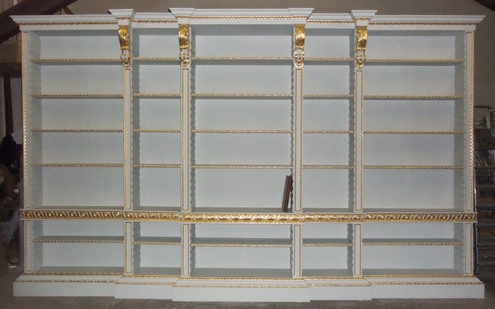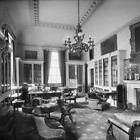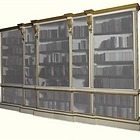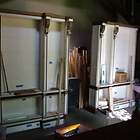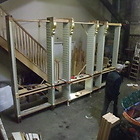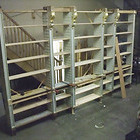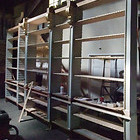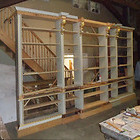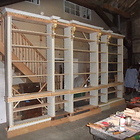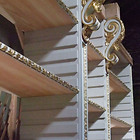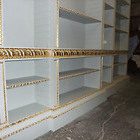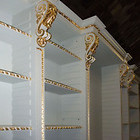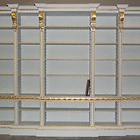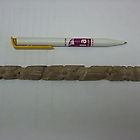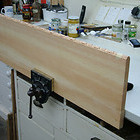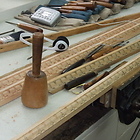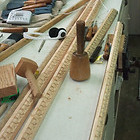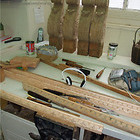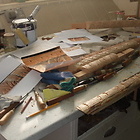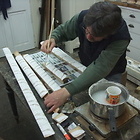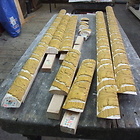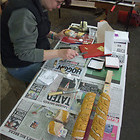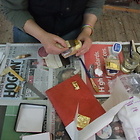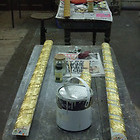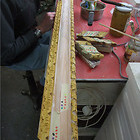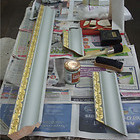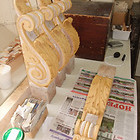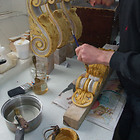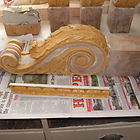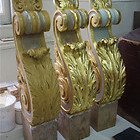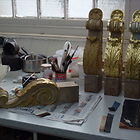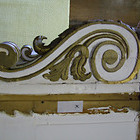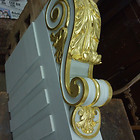William Kent Bookcase
William Kent Bookcase
William Kent (1685 – 1748) rose from the obscurity of a carriage painter’s apprentice to become Keeper of Pictures and principle painter to the Crown and the foremost British architect in the second quarter of the 18th century. He designed Devonshire House in the 1730s and also some of the furniture, including this bookcase. The house was demolished in 1924, at which point it was taken to Chatsworth House.
This bookcase is a piece of furniture designed to impress, in a room reserved personally for the Duke. It is made of “pinus silvestris,” Scots pine, with shelf supports of oak and shelf facings of mahogany. Unlike bookcases from later periods which were made in sections that could be taken apart and easily transported, this was carried into
We remade the centre section in such a manner that the bookcase was comprised of six sections which could be safely transported and reassembled. The dado carvings were remade where missing, along with the cornice and skirting carvings in the new centre section.
A short history of the restoration process
The bookcase arrived at my workshop in 4 pieces and boxes of bits, all heavily over-painted. Our instruction was to strip it back to the original paint where possible, restore the woodwork and gild where it had been originally.
There were many other technical and research challenges, like the fact that the central section had been halved in width.
After working on the piece for some time it became clear that not all the original elements were present. On investigation we discovered that Sotherbys had sold a considerable amount of the dado carving in a separate lot at the Chatsworth sale. We asked the new owner by letter through Sotherbys if we could purchase the carving or at least have sight of it but after a number of approaches there was no reply. At this point with the aid of the original photograph of Sotherbys it was agreed that the missing carving would be redone.
After we had made more progress in the job, we found evidence of the original racking system for the shelves which had been hacked off. This then meant that the shelves were not original and were too short. So after further research into the few known
At this point I realised that a short piece of carving repair on the skirting which had to be removed because it didn't fit was actually a piece from the original shelves, including fortunately the end detail.
There was no question in my mind that new shelves with the correct carving had to be made in order for the bookcase to be itself again.
Aside from the new racking system on twenty sections of the carcass, we made and ran the moulding on the 25 new shelves in first quality Scots pine which is no longer commercially available. We had this timber in stock since we had bought 250 year old trees from Buccleuch estates and air dried them for the last seven years. After selecting from our collection of carving chisels the right shapes to match the original carver's tools, we made test pieces. The front edges were then marked out and carved with the design going left and right from the centre point on each shelf. They were then sized, gessoed, bouled and water gilded. They were then fitted and numbered with Roman numerals, hand sanded and painted.
This has been a challenging job which took two years to complete. However it has been a privilege to be able to work on such a historic piece.
Like most architectural pieces the full impact doesn't come across in a photograph, since it is its presence in relation to the human form that brings it to life. I have no doubt that if placed in the right room this bookcase will be magnificent.

